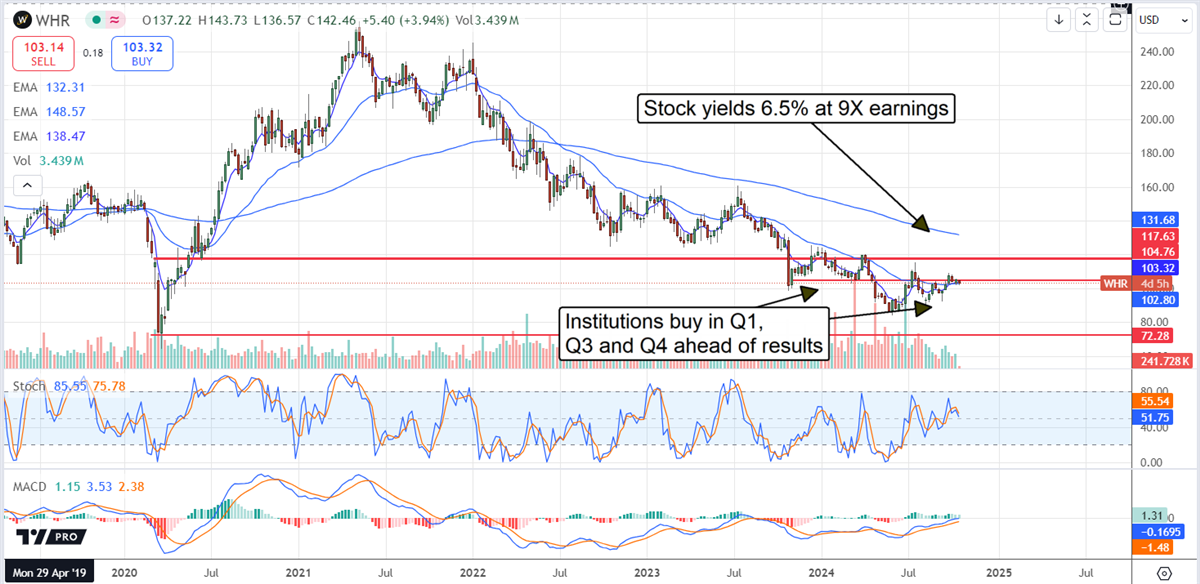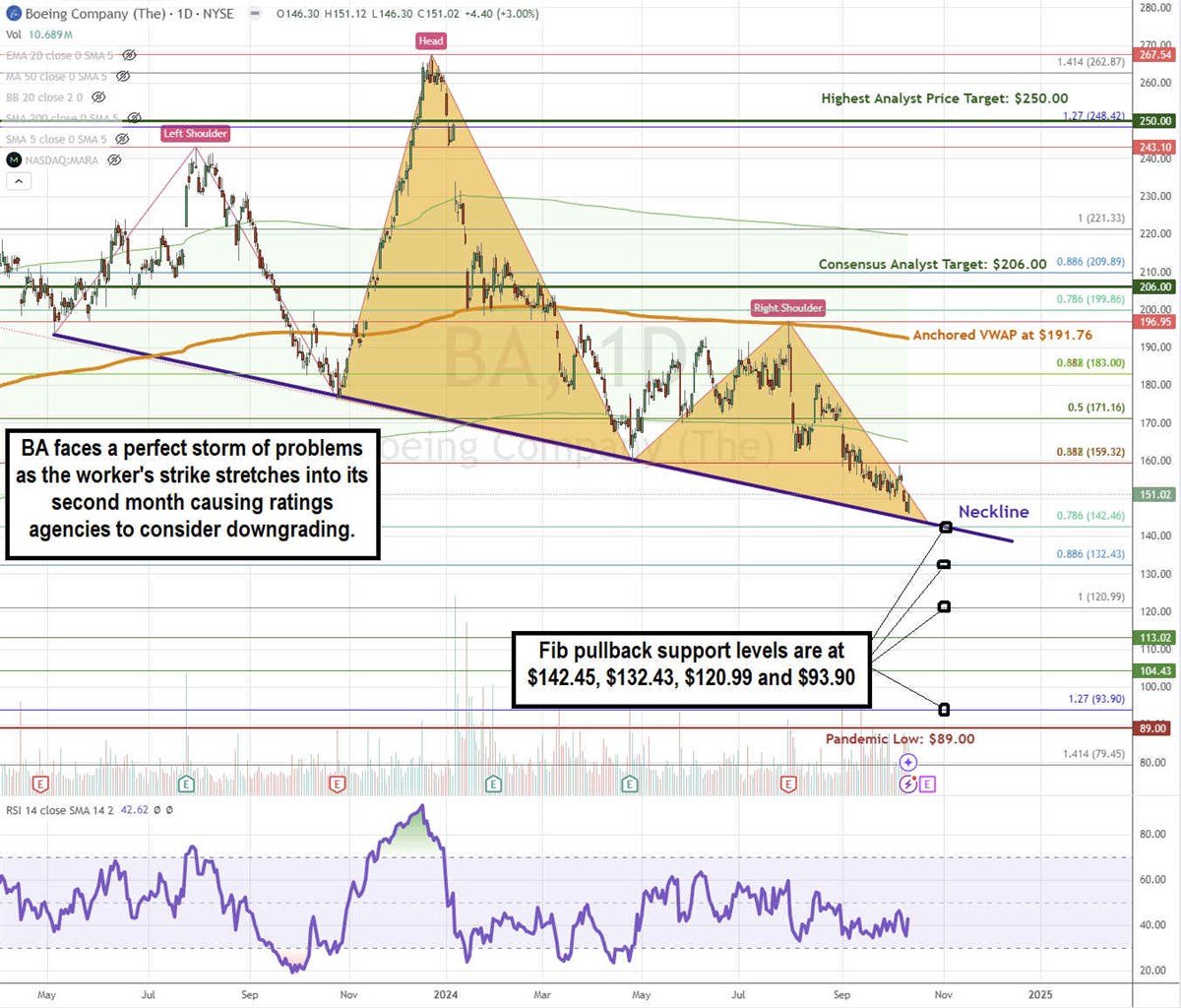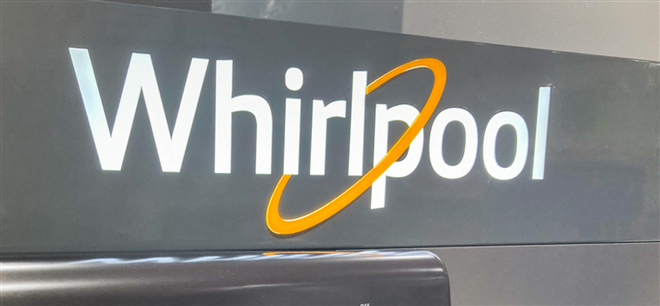Ticker Reports for October 14th
Whirlpool's High Dividend Yield Is Too Good to Pass Up
The time to buy Whirlpool (NYSE: WHR) for its dividend is now. The stock offers a buying opportunity that has been years in the making and will be viewed favorably for years to come. Trading at 9x earnings and yielding over 6.5%, the stock has a limited downside, market-beating yield, and a robust outlook for stock price reversal in 2025.
The company isn’t out of the weeds yet and faces continued market pressure from macroeconomic conditions and competition. However, it is on track to resume earnings growth in fiscal 2025 and produce sufficient cash flow to sustain its healthy balance sheet and return capital to shareholders.
Whirlpool Trades at Rock-Bottom Prices
Whirlpool’s 9x P/E multiple is not the cheapest the stock has traded in recent years but is at the very low end of the range, more than 40% below the 10-year average. The valuation relative to 2025 is even lower because of the earnings growth outlook, which assumes a high-single-digit pace sufficient to sustain distribution health. Assuming the stock can sustain its 9x valuation relative to current year earnings, the stock price should increase over the next 12 months on earnings growth. Even so, the dividend is reliably safe.
Highlights from the Q2 F2024 results include a sequentially wider margin driven by internal efficiencies and the expectation of additional gains in the year’s second half. That’s good news for the dividend and helps ensure its reliability because of improving coverage. The payout ratio is up in 2024 on a decline in earnings power but still manageable at 60% of the 2024 and 55% of the 2025 EPS forecast, with earnings growth expected over the long term.
Whirlpool had a negative cash flow quarter in FQ2, but ultimately, it was a good quarter for investors. The cash burn is due primarily to debt repayments and is less than the previous year. The net result is an expected decline in cash offset by debt reduction that leaves total long-term liability very low. The total long-term liability is about 2.5x equity and less than 0.5x assets, putting the business in a lean operating condition with relatively unimpeded cash flow, capable of sustaining capital returns, including share repurchases. Share buybacks were sufficient to reduce the count in Q2.
Analysts and Institutions Indicate a Price Floor of $100
Analysts and institutional activity helped send WHR shares to their lowest levels since 2020, with declining ratings, reduced price targets, and intermittent selling. However, the balance of institutional activity is bullish in 2024, with them buying on balance in Q1 and Q3 and activity aligning with congestion bands on the price chart. The congestion bands show market support at the $100 to $105 level, aligning with the analysts' consensus suggesting a floor for the market. Assuming the upcoming earnings report aligns with the expectations, analysts may lift price targets and sentiment ratings, providing a tailwind for the stock price.
Whirlpool Reaches Bottom in 2024
The stock price action in WHR reached its bottom in 2024 but has yet to signal a complete reversal. The market is consolidating and shows support at critical moving averages but needs to fire a stronger signal to take on a strongly bullish posture. The Q3 earnings release may trigger that signal. Until then, the downside is limited by the recent lows near $85, which may be retested if the second half is weaker than forecast.
The long-term forecast is for a total price reversal, which may not be completed until 2025. Falling interest rates are expected to reinvigorate the demand for new houses and unstick the existing home market, fueling demand for appliances. In that scenario, the stock price could gain upward of 100%.

7 Stocks Set to Soar Before 2024 Ends—Are You Ready?
Earnings Season: Your FREE Ticket to Trading Success
Don't just survive earnings season - learn how to potentially thrive. Discover how to time your trades for maximum potential profit.
Bonus: Daily earnings updates delivered straight to your inbox.
Holiday Spending Boom Ahead: 3 BNPL Stocks Poised for Gains
As the holiday season approaches, consumers prepare for another hit to their pocketbooks with their annual holiday shopping. Inflation and high interest rates have caused consumers to tighten their spending habits in the consumer discretionary sector. The holiday shopping season is when most retailers have the opportunity to get in the black. It's also the busiest time of year for buy-now-pay-later (BNPL) services, which continue to grow in usage. Here are 3 stocks to consider buying now to profit from the upcoming holiday spending season.
Affirm: The Pioneer in BNPL and Growth Monster
As the pioneer in BNPL, Affirm Holdings Inc. (NASDAQ: AFRM) continues to experience hypergrowth. It is also partnered with Amazon.com Inc. (NASDAQ: AMZN), Apple Inc. (NASDAQ: AAPL), Shopify Inc. (NYSE: SHOP), Target Co. (NYSE: TGT), and Walmart Inc. (NYSE: WMT) to offer their BNPL services to the retailer's customers. The company is receiving accolades and upgrades this holiday season as it has become apparent this is when they see the most business. The business model of BNPL is simple and provides a win-win opportunity. Consumers can make purchases taking microloans payable in preset bi-weekly payments, usually interest-free. Merchants are able to complete sales that otherwise may not have occurred. Affirm takes its fee from merchants to facilitate the transaction. Affirm also offers monthly payment options, which can incur interest for up to four years (60 months).
GAAP Profitability Is Becoming More of a Reality
Affirm has been losing money every quarter since its inception. However, revenue has grown by double-digits while losses continue to shrink. Its CEO, Max Levchin, former co-founder of PayPal Holdings Inc. (NASDAQ: PYPL), stated in its fiscal fourth quarter of 2024 shareholder letter that the company is on target to become GAAP profitable by the end of the fiscal full year 2025.
It's just a matter of scale and time at this point. The more revenue they generate, the less money they lose. Affirm lost 14 cents per share in the first Q4 of 2024, which still beat consensus estimates by 34 cents. Revenue grew 48% YoY to $659.2 million, besting consensus estimates by over $55 million. Affirm raised its fiscal Q1 2025 revenue guidance higher to $640 million to $670 million, which crushes the $625.04 million consensus estimates.
Analysts Upgrade Ahead of the Holidays
This holiday season should set up for another record-breaking quarter. Analysts certainly agree as they raised their ratings and price targets. On Oct. 8, 2024, BIG upgraded Affirm stock to Buy from Neutral, which simultaneously downgraded shares of credit card network American Express Co. (NYSE: AXP) to Sell. Morgan Stanley upgraded Affirm to Equal Weight from Underweight, as it sees higher income spenders also joining the platform to avoid the high interest rates from credit card issuers. Wells Fargo upgraded Affirm shares to Overweight with a $52 price target.
Afterpay: Pay-in-4 Model Is Simple
Block Inc. (NYSE: SQ) acquired BNPL platform Afterpay for $29 billion on Feb. 1, 2022. The company has since integrated it into its Cash App ecosystem, providing users with BNPL options through Afterpay. Afterpay's model is simple: buy the product and pay for it in four bi-weekly payments. There are no credit checks involved, nor interest rates applied under the four payment option. Afterpay collects a fee from merchants comprised of a base of 30 cents plus 4% to 6% of each transaction. Consumers can also opt for monthly payment plans for purchases over $400 in six to 12 months, but interest rates accrue, ranging between 6.995 to as high as 35.99%. Loan amounts are determined on a case-by-case basis, ranging up to $2,000.
Growth Through the Cash App Ecosystem
Afterpay has five million users, and that number grows with increasing Cash App users which is at the 57 million mark as of June 2024. Afterpay also has retailer partners like Nordstrom Inc. (NYSE: JWN), The Gap Inc. (NYSE: GAP) and Old Navy offering its services to its customers. While Block is not a pure-play BNPL, you also get multiple ecosystem businesses with the stock which include its legacy Square network and Cash App ecosystem. Afterpay’s gross merchandise volume (GMV) grew 21% YoY to $7.75 billion in Block’s second quarter of 2024.
Sezzle: Shop Online or In-Store Using the Mobile App
Sezzle Inc. (NASDAQ: SEZL) is a BNPL platform that also allows a pay in 4 installments option with a twist. Users need to pay a 25% downpayment of the purchase price first upfront. It is interest-free under the 4 payment plan paid out over six weeks. It has also partnered with major brands to get exclusive deals from Amazon.com, Walmart, Kohl’s Co. (NYSE: KSS) and Nike Inc. (NYSE: NKE).
Building Up Your Sizzle Payment History
Sezzle users can download the app and set up the Virtual Card to shop online or in-store. Users can choose a brand or product and select the Pay with Sezzle option at checkout. Users can select their payment plan. With Sezzle, the financing is determined on a case-by-case basis, but users who build up a history with the company will usually get more financing. Therefore, there is also a single payment option where a user can opt to purchase the item without using BNPL but through Sezzle to build history. Meanwhile, Sezzle still charges the merchant 30 cents and 6% transaction fees.
Users can use the Sezzle App, which has a Virtual Visa Inc. (NYSE: V) card to enable in-stop purchases. Users must determine how much they plan to spend and then select the payment schedule and terms to fund the Visa card. After that they are free to spend on in-store items.
Sezzle has over 3.4 million active users and is accepted by more than 45,000 merchants in the United States and Canada.
Sezzle’s Stock Surge May Have Gotten Ahead of Itself
Sezzle shares are up 776% year-to-date (YTD), but the volume is much lighter than the stocks above, averaging less than 100,000 shares. Despite the run-up, shares are only trading at 26.79x forward earnings. The consensus analyst price target among three analysts is $174.00, with the highest target at $185.00.
Musk warns humanity: "Obsolete"
The 'invasion' I've discovered has nothing to do with the border crisis. What's happening at our southern border is a travesty, but the 'invasion' I've found will have 10 times greater effects on our economy, and ultimately our way of life.
Go here to see why.Boeing: A Perfect Storm of Trouble Is a Loaded Buying Opportunity
The world's largest manufacturer of airplanes, The Boeing Co. (NYSE: BA), can't seem to catch a break; following Murphy's Law, everything that can go wrong did. In Boeing’s case, trouble with the Federal Aviation Administration (FAA) concerning safety compliance and production issues, financial issues threatening a rating agency downgrade, swelling debt of nearly $60 billion and strike negotiations with its 33,000 machinists hitting a dead end.
To add a cherry on top, Boeing just announced even larger losses for its third quarter of 2023 and plans to lay off 17,000 workers. With the aerospace sector giant's stock near two-year lows, long-term risk-averse investors may view this as a rare buying opportunity when sentiment is near all-time lows. While its problems read like a laundry list, it also underscores and itemizes the potential catalysts for recovery.
The Strike Negotiations Come to a Halt
Production halts for its high margin 737 MAX airplanes, 777X, and 767 programs commenced on Sept. 13, 2024, when nearly 33,000 workers and members of the International Association of Machinists and Aerospace Workers (IAM) union walked off the job, striking against unfair labor practices. Negotiations had Boeing increase wage proposals from 25% to 30% over four years with a restatement of bonuses and improvements to healthcare and retirement benefits. Workers are asking for a 40% wage hike and reinstatement of its scrapped defined-benefit pension. Boeing stated it withdrew its offers since further negotiation attempts made no sense. The fears of a prolonged strike lasting through 2024 have caused ratings agencies to warn of a downgrade.
S&P Places Boeing on CreditWatch Negative
Standard and Poor's (S&P) placed Boeing on CreditWatch Negative stemming from strike-related financial risk on Oct. 8, 2024. S&P estimates Boeing will incur a $10 billion cash outflow in 2024 due to working capital building needed to support its manufacturing process overhaul and strike-associated costs. The agency believes Boeing will need to raise cash to fund operations and working capital and meet debt maturities. Its BBB- issuer credit, senior unsecured debt, A-3 short-term and commercial paper ratings were placed on CreditWatch with negative implications.
A CreditWatch listing raises the likelihood of a downgrade if the strike continues through the end of 2024 if the company can’t raise sufficient capital to increase its financial leverage. Moody’s and Fitch also warned of downgrades with a prolonged strike.
Boeing’s debt rose to nearly $60 million after issuing $10 billion in debt in May. Boeing has to decide how it will raise cash and whether it will further dilute shareholders with preferred stock or convertible bond offerings.
Boeing Pre-Announces Revenue Warning for Q3 2024
On Oct. 11, 2024, Boeing pre-announced it will recognize $5 billion of charges and changes to programs across its Commercial Airplanes and Defense, Space & Security divisions when it reports Q3 2024 earnings results on Oct. 23, 2024. Boeing used up $1.3 billion of cash and racked up GAAP losses of $9.97 per share in the third quarter.
The Commercial Airplanes segment will incur a $3 billion pre-earnings charge on its 777X and 767 programs. It will also conclude production of the 767 freighters in 2027 (after delivering the remaining planes), recognizing a $400 million pre-tax charge reflecting the impact of the IAM strike. Its Boeing Defense, Space & Security (BDS) segment will recognize pre-tax earnings charges of $2 billion on the KC-46A, T-7A, Commercial Crew, and MQ-25 programs. Revenue guidance was cut to $17.8 billion versus $18.49 billion consensus estimates.
Boeing plans to cut 10% of its workforce or 17,000 employees, including executives, managers and workers. Incidentally, Boeing isn't allowed to fire strikers, and the strike is still in place. Its 777X deliveries have been extended to 2026 due to the strikes.
Can Things Be So Bad They’re Good for the Stock?
With third-quarter of 2024 earnings due out premarket on Oct. 23, 2024, investors may want to wait for the report. Even though they pre-announced lower revenue guidance for the upcoming quarter, the impact on its fourth quarter and the decision on how to raise cash has yet to be revealed. The new CEO, Kelly Ortberg, formerly of Rockwell Collins, only took office just over two months ago.
Despite all its problems, the company is a duopoly with Airbus. The company delivered just 33 planes in September, which was seven less than in August. Even Southwest Airlines Co. (NYSE: LUV), with a fleet of just Boeing 737 planes, has to wait for delivery even if the delivery schedule is extended.
Boeing continues to gain contracts as the only American airplane manufacturer in town, or country in this case. Boeing’s defense contracts surged 40% YoY to $34 billion. However, its fixed-price contracts on next-generation programs are losing money due to margin fluctuations despite strong demand for aircraft and bombs. Airlines still need new airplanes, so they have no choice but to wait out extended delivery schedules. Even the White House is trying to get the strike towards a conclusion as the Biden administration continues to pressure both sides toward an agreement.
The bar has been set low for its upcoming third-quarter earnings report. Guidance for the fourth quarter and full year 2024 is the wildcard and any conclusion to the strikes would be a positive catalyst that could slingshot shares higher.
BA Stock Is in a Head and Shoulders Pattern
A head-and-shoulders pattern is a bearish pattern comprised of three price peaks (left shoulder, head, and right shoulder), concluding with a breakdown through the neckline, which is formed by connecting the bottoms of each peak leg. A reversal can also trigger when the stock rallies through its right shoulder peak.

BA formed the left shoulder peak at $243.10, then the head peak at its highest swing high at $267.54, and the right shoulder peak at $196.96 near the daily anchored VWAP resistance. The neckline has been formed and triggers a breakdown under $142.46. The daily RSI has been chopping sideways around the 42-band. Fibonacci (Fib) pullback support levels are at $142.45, $132.43, $120.99, and $93.90.
Boeing’s average consensus price target is $206.00, and its highest analyst price target sits at $250.00. It holds 15 Buy ratings, seven Hold ratings, and two Sell ratings from analysts.
Actionable Options Strategies: Selling pressure has been steady on BA stock. It’s waiting on a capitulation bottom, which may trigger after the earnings report. Bullish investors can consider using cash-secured puts to buy BA at the fib pullback support levels for entry after its earnings report on Oct. 23, 2024.
Speculators looking for a large earnings reaction may consider a long straddle closer to the earnings release. Bullish investors looking for short-term upside can consider bull call debit spreads to limit capital and minimize the downside with capped upside.






0 Response to "🌟 Whirlpool’s High Dividend Yield Is Too Good to Pass Up"
Post a Comment